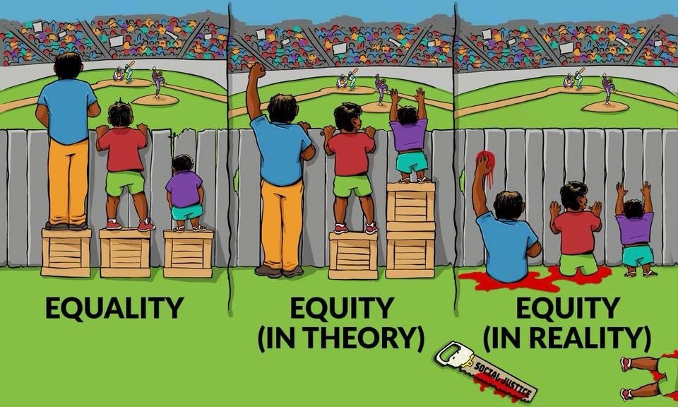As regular readers know, I spent much of the past two years co-leading the Building Bridges Initiative, which sought to bring education reformers from left, right, and center together (again). One of the most useful moments in our deliberations came when one participant introduced the notion of a “suitcase word.” Like a suitcase, such words may look the same to everyone, but we each have different ideas of what may lie inside. In order to avoid misunderstandings or unnecessary conflict, it’s helpful to “unpack” these words and be crystal clear about the concepts we’re discussing.
Suitcase words are everywhere in our political conversations and in K–12 education, including “social justice,” “parental rights,” and “accountability.” But the granddaddy of them all is surely “educational equity.” In coming weeks, I aim to unpack this phrase and discuss what it would mean to do educational equity right (double meaning intended).
My experience is that “educational equity” lands very differently with my friends on the left versus the right. Their suitcases hold strikingly different contents. On the left, the phrase conjures up praiseworthy efforts to help low-income kids and kids of color succeed—to make up for past and present injustices by ensuring that students from marginalized groups have access to schools, teachers, and instruction that are just as good, if not better, than those enjoyed by their more advantaged peers. Who could be against that? Thus, my friends on the left don’t understand why their friends on the right are triggered by the phrase.
But that’s because, in conservative circles, there’s much alarm over what we see as the move away from “equality of opportunity” as the goal in American society and its replacement by “equality of outcomes.” This alarm stems from claims, like Ibram X. Kendi’s, that “the only remedy to past discrimination is present discrimination. The only remedy to present discrimination is future discrimination.” Which goes on to include the assertion that any racial disparity (in educational attainment or achievement, or involvement in the criminal justice system, or wages, or anything else) is by definition racist. Conservatives view this as a vast oversimplification and at odds with notions of personal responsibility and agency, not to mention meritocracy. It also paves the way for policies that we tend not to like, such as affirmative action and income redistribution.
So when liberals see the educational equity suitcase, they picture good things for poor kids and kids of color. When conservatives see that same suitcase, they picture Kendi-style discrimination and redistribution with a soupçon of accusation and implied guilt.
If we could unpack the suitcase, however, we might find a measure of agreement. For example, few people on the left or right would defend our (past) funding system that regularly sent more money to schools serving rich kids than poor kids. Nor would many disagree that it’s more expensive to effectively educate poor students than rich ones, and thus that progressive funding policies are appropriate. (This is the classic “equity” versus “equality” example. It’s not enough to provide equal funding for all kids; we must provide more money to high-poverty schools in order to ameliorate disadvantage.) Thus, we can find common ground around school funding reforms that provide adequate and equitable funding to high-poverty schools, as many red, blue, and purple states have embraced in recent years.
I’m not saying that identifying alternative words to use in place of “educational equity” will resolve all of our left-right debates; these have been around forever and will be here long after we’re gone. What we can do, however, and something surely worth trying to do, is to identify specific education policies and practices that embrace a version of “equity” that can garner broad support across the ideological spectrum and benefit the greatest number of students. Let me suggest three rules for doing so.
1. When aiming for equity, we should level-up instead of leveling-down. In graphic form, we should avoid modeling our actions on this meme, inspired by Kurt Vonnegut’s “Harrison Bergeron”:

As one of my favorite Substackers, Noah Smith, writes about San Francisco’s attempt to ban high-achieving students from taking algebra until the ninth grade:
When you think about the idea of creating equity by restricting access to advanced math classes, it’s pretty much impossible to avoid the conclusion that the idea is to make all kids equal by making them equally unable to learn.
This is obviously terrible for the high-achieving students who don’t get to live up to their full potential, as well as for low-achievers subjected to the “soft bigotry of low expectations.” It’s a version of “equity” that we should all reject out of hand.
Indeed, as I argued recently, we should avoid pitting equity versus excellence. Whether the goal is to narrow achievement gaps, diversify gifted and talented programs, or reduce bias in grading, the strategy should always involve raising the bar, not lowering it.
2. Focus on closing gaps between affluent students and their disadvantaged peers, not between high-achieving students and their lower-achieving peers. While most economically disadvantaged students are relatively low-performing academically, due to the challenges of growing up in poverty, thankfully not all are. And if we create policies that encourage schools to prioritize the needs of low-achievers over high-achievers (like this one), we create a double-disadvantage for high achieving, low-income (HALO) students. There’s no moral justification for doing so, nor is there a good argument from a societal level either, given that these HALO kids are the ones with the best opportunity to use great schools (and selective colleges) to pole-vault into the middle class and above and into our leading professions.
For sure, it’s critical to raise the achievement and other outcomes of our lowest-performing students. But not at the expense of their higher-achieving peers.
3. Focus equity initiatives primarily on class, not race. Let me be clear: Anti-discrimination efforts must continue to be race-conscious, in line with longstanding civil rights laws. But when we switch our focus from ensuring fair treatment to giving disadvantaged students a boost, we should be cautious about defining disadvantage on racial grounds. On school funding, for example, it’s easy to justify sending extra dollars to high-poverty schools, but much harder to justify additional funding to upper-middle class Black schools. And given that the vast majority of the racial disparities in education are correlated with (if not caused by) socio-economic disparities, we can largely work towards racial equity via class-conscious but race-neutral approaches.
I understand that such an approach won’t satisfy all advocates on the left, but it will garner greater support from the center and the right.
In future posts, I’ll address how to apply these rules to debates around school funding, accountability systems, advanced education, school discipline, career and technical education, and grading reform.
We’ll explore: What would it mean to level up, not level down? For all economically-disadvantaged students, including high-achievers? With a primary focus on class, not race? In other words: How can we do equity right?
Stay tuned!
Michael J. Petrilli is president of the Thomas B. Fordham Institute, visiting fellow at Stanford University’s Hoover Institution, and an executive editor of Education Next.
This post originally appeared on the Fordham Institute’s Flypaper blog.
This article appeared in the Spring 2024 issue of Education Next. Suggested citation format:
Petrilli, M. (2024). How to Unpack an Ideological Suitcase. Education Next, 24(2), 5.



